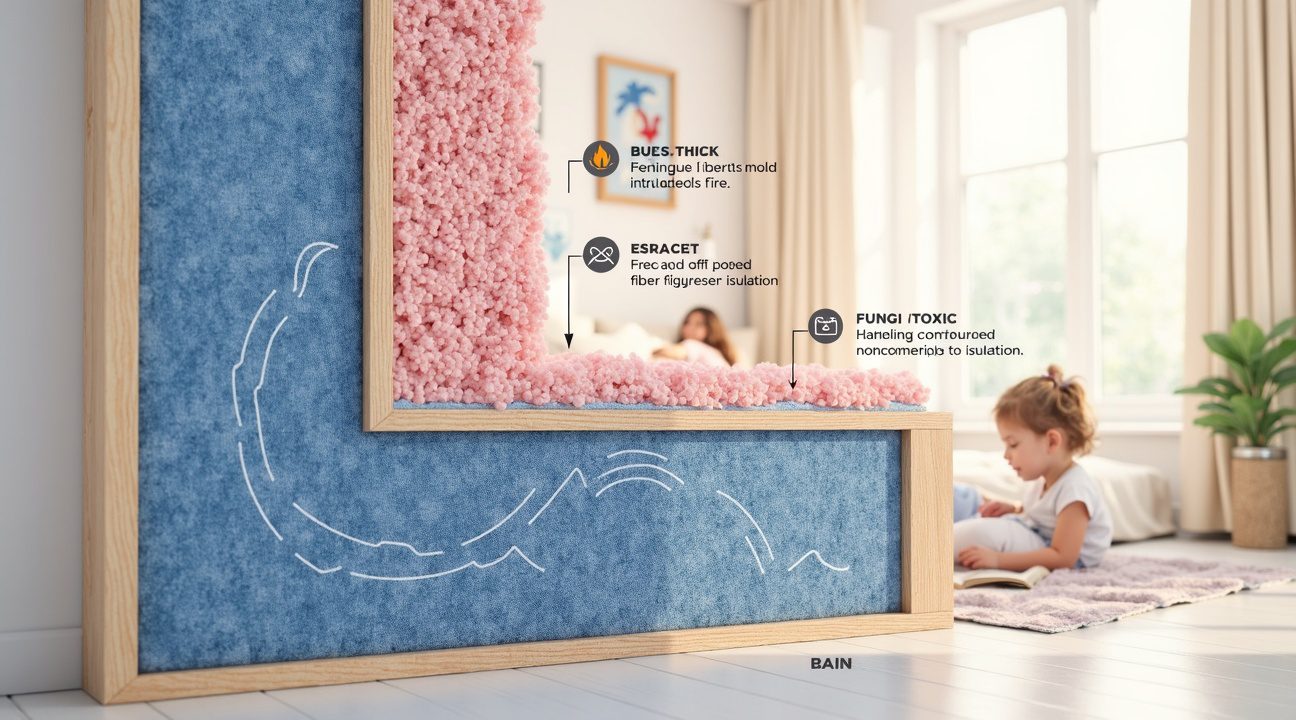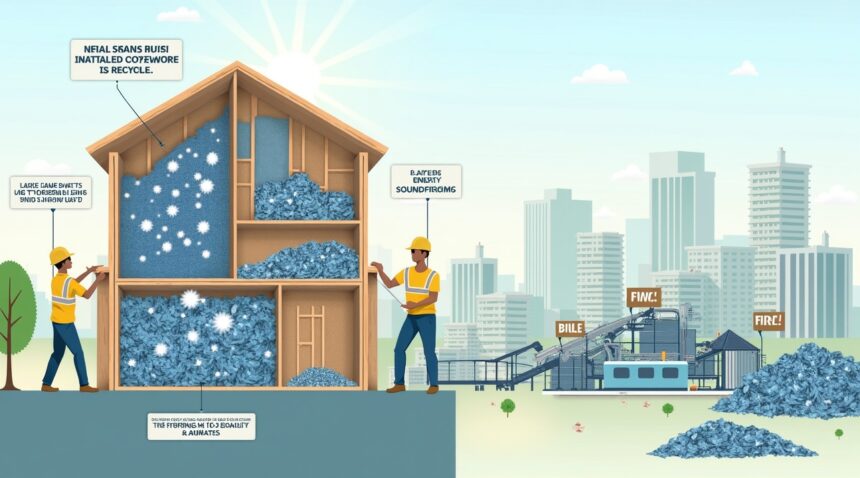The U.S. generates 11.3 million tons of textile waste each year, and an innovative industry has emerged to repurpose discarded denim into high-performance insulation for homes and buildings.
Recycled Denim Insulation: A Sustainable Solution
The recycled denim insulation market is experiencing rapid growth, projected to reach $500 million by 2025. Its rise is being fueled by a 15% compound annual growth rate expected through 2033. Environmental policies, along with the construction industry’s shift toward greener building practices, are major drivers behind this trend.
Key Takeaways
- Market Growth: The recycled denim insulation industry is projected to reach a value of $500 million by 2025, with a 15% annual growth rate. Construction companies account for over 50% of total market demand.
- Energy Savings: Homeowners can reduce heating and cooling costs by up to 15% when adopting recycled denim insulation, which provides effective thermal protection with R-values ranging from R-13 to R-19.
- Superior Performance: This eco-friendly insulation absorbs about 35% more sound than traditional materials. It also offers fire resistance naturally through a boric acid treatment, without introducing harmful chemicals.
- Environmental Impact: Manufacturing recycled denim insulation requires 75% less energy compared to new materials, while significantly reducing textile waste in landfills.
- Safety Advantages: Unlike fiberglass, recycled denim insulation is free from formaldehyde and volatile organic compounds, making it safer to install with no risk of skin irritation or respiratory issues.
For more on environmentally friendly construction trends and solutions, visit this EPA resource on textile sustainability.
From Trash to Treasure: How 11.3 Million Tons of Annual Textile Waste Found New Life in Your Walls
Every year, Americans toss aside mountains of clothing that could have a second life inside their homes. The U.S. generates around 11.3 million tons of textile waste annually, accounting for approximately 5.8% of municipal solid waste according to EPA data from 2018. This staggering amount of discarded fabric represents both an environmental challenge and an unexpected opportunity.
Denim recycling has emerged as a powerful solution to this waste crisis. Old jeans that once filled closets and drawers now find purpose between wall studs as effective insulation material. I’ve witnessed this transformation firsthand, where discarded denim gets shredded, treated, and reborn as a sustainable building material that keeps homes comfortable year-round.
The recycled cotton denim insulation market is valued at approximately $500 million by 2025, with expected growth driven by sustainability initiatives and green building projects. This isn’t just about reducing waste—it’s about creating value from materials that would otherwise decompose in landfills for decades. The industry is projected to grow at a 15% compound annual growth rate (CAGR) from 2025 to 2033, supported by regulation and advances in eco-friendly construction.
Industry Leaders Driving the Denim Revolution
Several companies have positioned themselves at the forefront of this recycling revolution:
- Bonded Logic Inc leads with their UltraTouch denim insulation, transforming post-industrial cotton into high-performance building materials
- Recovery Insulation Ltd specializes in converting textile waste into thermal and acoustic insulation solutions for residential and commercial applications
- SOPREMA GROUP leverages their extensive experience in building materials to develop innovative denim-based insulation products
These companies don’t just process waste—they’ve created sophisticated supply chains that collect, clean, and transform denim into products that often outperform traditional insulation materials. The recycled denim maintains excellent thermal properties while offering superior sound dampening capabilities.
The circular economy concept drives much of this innovation. Instead of following the traditional take-make-dispose model, denim recycling creates a closed loop where waste becomes raw material. This approach reduces the need for virgin materials, decreases energy consumption in manufacturing, and keeps textiles out of landfills where they contribute to methane emissions.
Construction professionals increasingly specify recycled denim insulation for projects seeking LEED certification or other green building standards. The material’s natural fire resistance eliminates the need for chemical flame retardants commonly found in synthetic alternatives. Additionally, workers appreciate that denim insulation doesn’t irritate skin or respiratory systems during installation.
Processing techniques have evolved significantly, allowing manufacturers to handle various denim weights and compositions. Modern facilities can separate cotton fibers from elastic components, remove metal hardware, and even process denim blends containing synthetic materials. This flexibility means more types of discarded jeans can enter the recycling stream.
The environmental benefits extend beyond waste diversion. Manufacturing recycled denim insulation requires substantially less water than producing new cotton or synthetic insulation materials. Given that conventional cotton production consumes enormous amounts of water, this represents a significant conservation achievement. Some estimates suggest that recycling denim uses 75% less energy than creating new insulation from raw materials.
Market growth reflects increasing consumer awareness about sustainable building practices and their long-term cost benefits. Homeowners discover that recycled denim insulation often pays for itself through reduced energy bills while supporting environmental goals. Building codes in various states now recognize recycled textile insulation as acceptable alternatives to traditional materials.
The transformation from discarded clothing to functional building material represents innovation at its finest. What once represented waste streams now fuel a rapidly expanding industry that benefits construction professionals, homeowners, and the environment simultaneously. This shift demonstrates how creative thinking can turn environmental challenges into economic opportunities.

Why Denim Insulation Outperforms Traditional Materials in Sound and Safety
Recycled denim insulation delivers superior acoustic performance that sets it apart from conventional materials. This innovative insulation absorbs approximately 35% more sound than typical insulation options, making it an excellent choice for both residential and automotive applications. The dense fiber structure of repurposed jeans creates natural sound barriers that significantly reduce noise transmission between rooms and from external sources.
From a thermal perspective, denim insulation provides reliable performance with R-values ranging between R-13 and R-19. These ratings match the effectiveness of traditional fiberglass insulation, ensuring homes maintain consistent temperatures while reducing energy costs. The recycled cotton fibers trap air efficiently, creating the thermal resistance necessary for effective climate control.
Safety and Health Advantages Over Traditional Options
Denim insulation’s safety profile represents one of its most compelling advantages. The material receives treatment with boric acid, which creates natural resistance to fire, mildew, pests, and fungi. This treatment process transforms old jeans into a fire-retardant material that meets building safety standards without compromising environmental friendliness.
Unlike fiberglass insulation, recycled denim doesn’t release harmful chemicals or carcinogens into indoor air. Homeowners can install this material without requiring extensive protective equipment, though dust masks remain advisable during installation. The absence of volatile organic compounds means families breathe cleaner air while enjoying enhanced comfort.
The material’s non-toxic composition eliminates concerns about skin irritation that commonly occur with fiberglass handling. Installation teams appreciate working with a product that doesn’t cause itching or require special clothing protection. This user-friendly characteristic makes denim insulation particularly attractive for DIY enthusiasts and professional installers alike.
Moisture resistance adds another layer of protection, as the boric acid treatment prevents mold and mildew growth even in humid conditions. This resistance helps maintain indoor air quality while extending the insulation’s lifespan. Property owners benefit from reduced maintenance requirements and improved long-term performance.
Environmental consciousness extends beyond the initial recycling process. Denim insulation can be reused and recycled again at the end of its service life, creating a circular economy model that minimizes waste. This recyclability factor appeals to environmentally aware consumers who want sustainable building materials without performance compromises.
The manufacturing process for denim insulation requires significantly less energy than producing new fiberglass materials. Hidden ways to save money include choosing recycled materials that often cost less than traditional alternatives while providing superior performance characteristics.
Temperature stability represents another key advantage of recycled denim insulation. The material maintains its insulating properties across wide temperature ranges without degrading or losing effectiveness. This stability ensures consistent performance regardless of seasonal weather variations or extreme climate conditions.
Acoustic benefits extend beyond simple sound absorption. Denim insulation reduces sound reverberation within rooms, creating more pleasant living and working environments. Recording studios and home theaters particularly benefit from these enhanced acoustic properties, which improve sound quality without requiring expensive specialized materials.
Installation flexibility makes denim insulation suitable for various applications, from wall cavities to attic spaces. The material cuts easily with standard tools and fits snugly without creating gaps that compromise thermal or acoustic performance. This adaptability simplifies installation while ensuring professional results.
Fire safety testing confirms that treated denim insulation meets or exceeds building code requirements for flame spread and smoke development. The natural fire-retardant properties provide peace of mind for property owners concerned about fire safety. Unlike some synthetic materials, denim insulation won’t contribute toxic smoke during fire emergencies.
Pest resistance eliminates concerns about rodents or insects nesting within insulation materials. The boric acid treatment creates an inhospitable environment for unwanted creatures while remaining safe for humans and pets. This protection maintains insulation integrity and prevents potential health hazards associated with pest infestations.
For those interested in a visual overview of denim insulation compared to fiberglass options, check out the following video:
https://www.youtube.com/watch?v=6m0n6WSPZDU

Your Energy Bills Could Drop 15% with This Sustainable Switch
I’ve discovered that homeowners can achieve remarkable energy savings by switching to recycled denim insulation. The Department of Energy confirms that this innovative material can reduce heating and cooling costs by up to 15%, creating substantial savings on monthly utility bills while supporting environmental sustainability.
The Science Behind Energy Efficiency
Recycled jean insulation performs exceptionally well because it contains 80% or more post-consumer recycled fibers. These dense cotton fibers create excellent thermal barriers that prevent heat transfer through walls, ceilings, and floors. Unlike traditional fiberglass insulation, denim insulation doesn’t settle over time, maintaining its R-value and energy efficiency for decades.
The material’s natural composition contributes significantly to improved indoor air quality. Since it contains no formaldehyde, volatile organic compounds, or synthetic chemicals, families breathe cleaner air year-round. This non-toxic profile makes it particularly valuable for homes with children, elderly residents, or anyone with respiratory sensitivities.
Installation Advantages and Practical Applications
Denim insulation comes in convenient batts or rolls that fit standard wall cavities and joist spaces. Installation becomes straightforward because the material doesn’t require protective equipment like masks or gloves, unlike fiberglass alternatives. Contractors appreciate how easily it cuts and shapes around pipes, electrical outlets, and irregular spaces.
The versatility of recycled denim insulation extends across multiple applications:
- Exterior walls for maximum thermal protection
- Attic spaces where temperature fluctuations are most extreme
- Crawl spaces to prevent moisture and temperature issues
- Interior walls for soundproofing benefits
- Basement ceilings to improve comfort in lower levels
Beyond energy savings, this sustainable insulation offers superior resistance to mold, mildew, and pest infiltration. The natural properties of cotton fibers repel insects while preventing moisture accumulation that leads to structural damage. These protective qualities eliminate common maintenance headaches that plague homeowners with traditional insulation materials.
Smart homeowners recognize that investing in money-saving upgrades like recycled denim insulation creates long-term financial benefits. The initial investment pays for itself through reduced energy bills, typically within three to five years depending on local utility rates and climate conditions.
Fire safety represents another compelling advantage of denim insulation. Cotton fibers naturally resist combustion and don’t produce toxic fumes when exposed to heat, unlike some synthetic alternatives. This safety feature provides additional peace of mind for families prioritizing home protection.
Professional installers consistently report that denim insulation performs better than expected in real-world applications. The material’s density and consistency create fewer thermal bridges and air leaks compared to traditional options. This superior performance translates directly into the 15% energy savings that make this sustainable switch financially attractive.
The sustainability aspect extends beyond recycling old jeans into useful building materials. Manufacturing denim insulation requires significantly less energy than producing fiberglass or foam alternatives. This reduced carbon footprint appeals to environmentally conscious homeowners who want to minimize their impact while improving home comfort.
Climate control becomes more consistent throughout the house when recycled denim insulation is properly installed. Hot spots and cold zones disappear as the material maintains steady temperatures in all seasons. This improved comfort enhances daily living while reducing strain on HVAC systems, extending their operational lifespan and reducing maintenance costs.
I recommend consulting with certified installers who understand proper installation techniques for denim insulation. While the material is forgiving and user-friendly, professional installation ensures maximum energy savings and performance. The investment in quality installation multiplies the long-term benefits and energy efficiency gains.
Construction Industry Embraces Denim: 50% Market Share and Growing
The construction sector has become the primary driver of denim insulation adoption, capturing over 50% of total market demand in 2025. This substantial market share reflects builders’ growing recognition of recycled denim’s superior thermal properties and environmental benefits compared to traditional insulation materials.
Medium-Thickness Variants Lead Market Penetration
Medium-thickness denim insulation dominates the market, securing approximately half of all sales across construction applications. Builders favor these products for their optimal balance of thermal performance and cost-effectiveness in standard residential and commercial projects. Thicker denim insulation variants gain traction in industrial settings, where enhanced energy efficiency standards mandate superior thermal barriers. Industrial facilities increasingly specify these premium options to meet stringent environmental regulations while reducing long-term energy costs.
Sector Distribution Drives Sustained Growth
Residential construction represents the largest application segment, accounting for 45% of denim insulation usage. Homebuilders appreciate the material’s non-toxic properties and excellent acoustic dampening capabilities, making it particularly attractive for family homes and multi-unit developments. Commercial and industrial sectors demonstrate robust expansion, with each experiencing 6–8% annual growth rates driven by tightening environmental regulations and corporate sustainability initiatives.
The automotive industry has emerged as an unexpected but significant adopter of denim insulation technology. Vehicle manufacturers integrate these materials for both thermal regulation and noise reduction in passenger compartments and engine bays. This application leverages denim’s natural fiber structure, which provides superior sound absorption compared to synthetic alternatives.
Textile manufacturers increasingly incorporate recycled denim insulation into eco-conscious product lines, creating a circular economy effect within the industry. Fashion brands seeking to reduce their environmental footprint utilize these materials in sustainable collections, while technical textile producers develop innovative applications for outdoor gear and home furnishing products.
Environmental regulations continue to accelerate adoption across all sectors. Building codes in numerous jurisdictions now favor or mandate sustainable insulation materials, creating regulatory tailwinds for denim-based products. Construction companies recognize that specifying recycled denim insulation helps projects achieve green building certifications while potentially qualifying for environmental tax incentives.
The material’s fire-resistant properties, achieved through natural cotton fiber treatment, eliminate the need for chemical flame retardants commonly found in synthetic insulation. This characteristic particularly appeals to health-conscious builders and homeowners concerned about indoor air quality. Additionally, denim insulation’s recyclability at end-of-life creates a compelling value proposition for projects targeting zero-waste construction goals.
Market analysts project continued expansion as manufacturing capacity scales to meet growing demand. The convergence of environmental awareness, regulatory pressure, and proven performance characteristics positions denim insulation for sustained growth across multiple industry sectors, with construction maintaining its leadership role in driving market development.

Market Segments Defined by Recycled Content Standards
The denim insulation market divides into distinct segments based on the percentage of recycled content each product contains. Understanding these categories helps contractors and homeowners make informed decisions about their insulation choices while supporting various levels of environmental responsibility.
Lower Recycled Content Segment
Products containing less than 80% recycled fibers command approximately 45% of the current market share. These insulation materials typically blend recycled denim with virgin cotton fibers or synthetic materials to achieve specific performance characteristics. Manufacturers often target this segment when they need to balance cost considerations with sustainability goals, as the lower recycled content allows for more competitive pricing structures.
This segment appeals to budget-conscious consumers who want some environmental benefits without paying premium prices. I’ve found that these products still offer decent thermal performance while introducing recycled materials into traditional construction practices.
High Recycled Content Premium Segment
Insulation products containing between 80% and 90% recycled content represent roughly 35% of the market. This segment focuses heavily on post-consumer recycled materials, meaning the denim comes directly from discarded jeans and other clothing items that consumers have worn and disposed of. Companies in this category emphasize their commitment to diverting textile waste from landfills.
Most denim insulation products available today include 80% or more post-consumer recycled materials, demonstrating the industry’s strong emphasis on sustainability practices. This high recycled content appeals to environmentally conscious builders and homeowners who prioritize green building certifications and reduced environmental impact.
The premium segment commands higher prices but delivers superior environmental credentials. Contractors working on LEED-certified projects or other green building initiatives often specify these higher recycled content products to meet strict sustainability requirements. Additionally, these materials help builders earn points under various green building rating systems.
Performance characteristics remain consistent across all recycled content levels, with thermal resistance values meeting or exceeding traditional insulation materials. The cotton fibers in recycled denim naturally resist settling and maintain their insulating properties over time, regardless of the specific recycled content percentage.
Market trends indicate growing demand for higher recycled content products as consumers become more environmentally aware. While hidden ways to save money might initially favor lower recycled content options, the long-term value proposition of premium recycled products often justifies the additional investment through improved durability and environmental benefits.
Green Building Revolution: Legislative Push Drives 2025 Insulation Trends
I observe a dramatic transformation occurring across the construction industry as sustainability takes center stage in insulation decisions. Denim insulation emerges as a frontrunner among eco-friendly alternatives, competing directly with sheep’s wool and innovative mushroom-based materials that builders increasingly embrace for residential and commercial projects.
Legislative Forces Accelerating Market Adoption
New building codes and green certification requirements create powerful incentives for contractors to specify recycled insulation materials. Federal tax credits now reward homeowners who choose sustainable building products, while state-level mandates push commercial developers toward greener construction practices. These legislative measures directly impact material selection, making denim insulation more competitive against traditional fiberglass options.
Several factors drive the accelerating growth I witness in recycled insulation markets:
- Government rebates reduce upfront costs for eco-conscious builders
- LEED certification requirements favor materials with recycled content
- Energy efficiency standards favor high-performance insulation solutions
- Municipal waste reduction goals encourage textile recycling programs
Market analysts project substantial expansion through the next decade as regulatory pressure intensifies and consumer awareness grows. Manufacturing capacity for denim insulation continues scaling up to meet increasing demand from both residential renovations and new construction projects.
However, significant obstacles still challenge widespread adoption of recycled insulation solutions. Price volatility affects raw material costs when denim waste streams fluctuate, creating uncertainty for manufacturers and contractors alike. Cotton prices directly impact production expenses, while transportation costs for collecting used textiles add complexity to supply chain management.
Education gaps persist among builders and homeowners who remain unfamiliar with denim insulation’s performance characteristics. Many construction professionals lack experience installing recycled materials, creating resistance to switching from familiar products. Architects and engineers require training on thermal properties, moisture management, and fire ratings specific to innovative building materials entering the marketplace.
Consumer perception challenges emerge as price-sensitive buyers question whether recycled options deliver equivalent performance to conventional insulation. Marketing efforts must emphasize that denim insulation matches or exceeds fiberglass in thermal resistance while providing superior acoustic dampening and non-toxic installation benefits.
Distribution networks continue expanding as major building supply retailers recognize growing demand for sustainable construction materials. Regional manufacturers establish partnerships with waste management companies to secure consistent denim feedstock, while national brands develop standardized products that meet diverse climate zone requirements.
I anticipate continued momentum as environmental regulations tighten and construction costs favor materials with dual functionality benefits. Denim insulation’s ability to divert textile waste while delivering excellent building performance positions it strategically for long-term market growth despite current implementation challenges.
Sources:
Verified Market Reports, “Recycled Cotton Denim Insulation Market Size and Forecast”
BuildDirect, “Denim Insulation: The Good And The Bad”
Archive Market Research, “Recycled Cotton Denim Insulation Insightful Analysis”
Life With Krich, “Using Recycled Denim as Eco-Friendly Building Insulation”
Earth911, “Good, Better, Best — Reducing Textile Waste in 2025”
Gold Star Insulation, “Benefits of Denim Insulation”
Insulation4Less, “Insulation Trends 2025: Innovations, Insights, and What’s Next”
Henry, “Why Builders Choose Denim Insulation Over Fiberglass”
DataHorizzon Research, “Recycled Denim Market Size, Growth & Forecast Report – 2033”
Koala Insulation, “Embracing Green Comfort: Eco-Friendly Insulation Choices for Fall”


